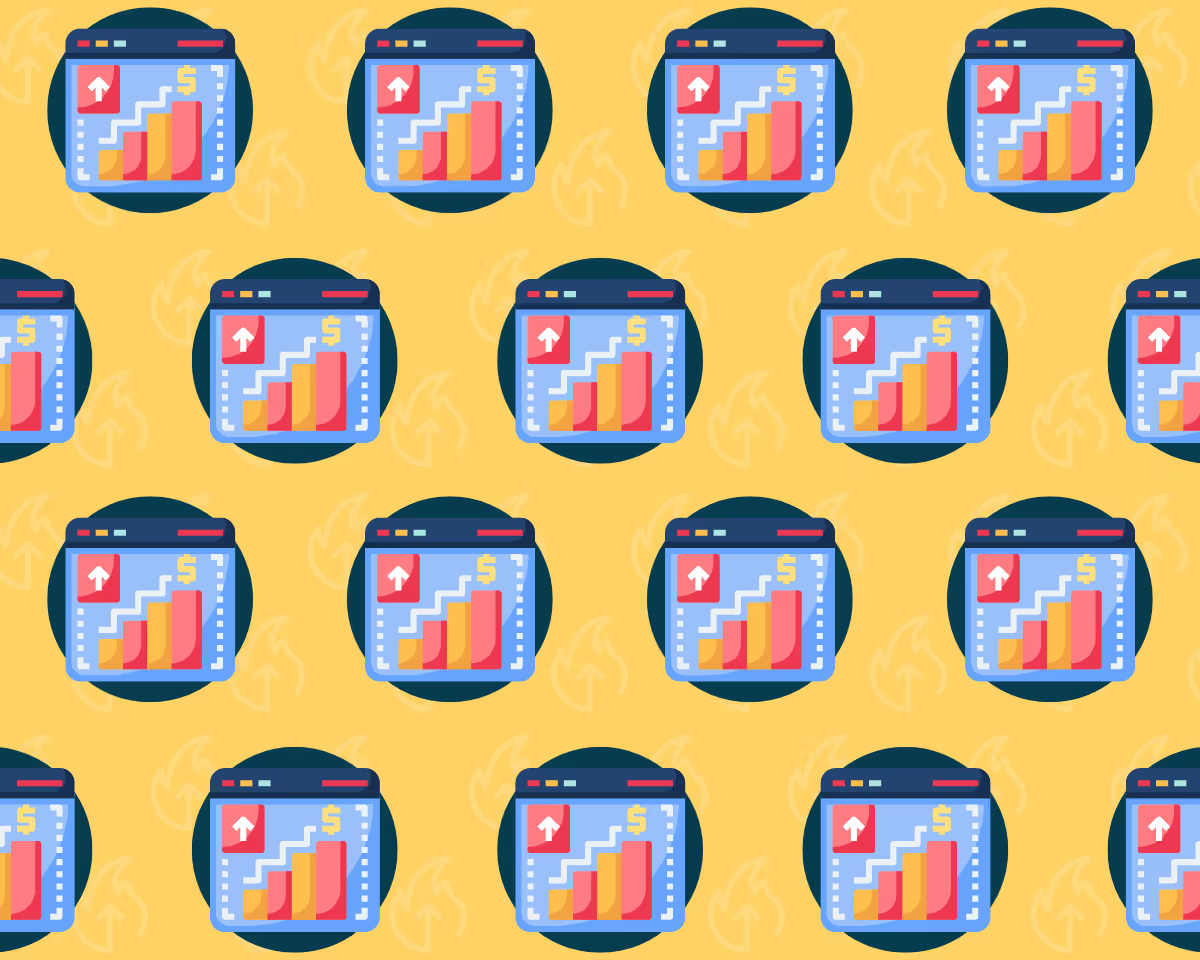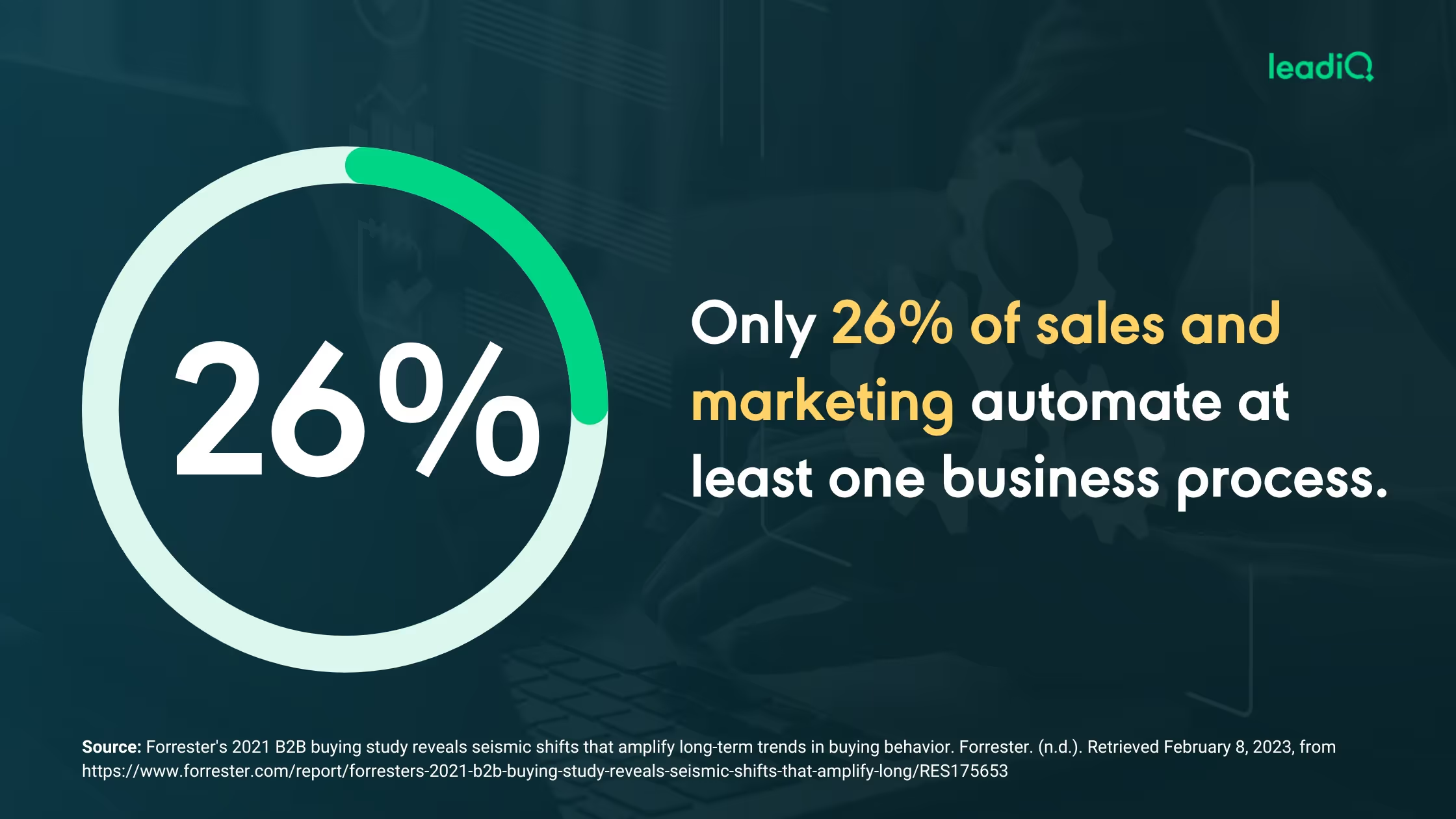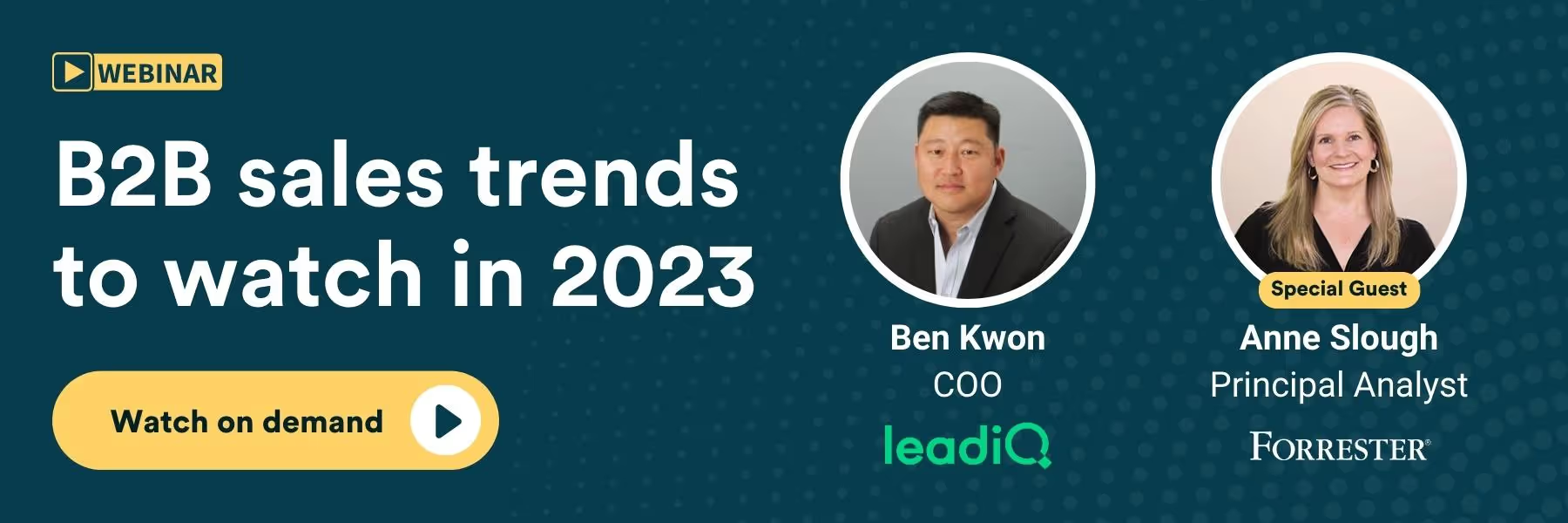Ready to create more pipeline?
Get a demo and discover why thousands of SDR and Sales teams trust LeadIQ to help them build pipeline confidently.





Get a demo and discover why thousands of SDR and Sales teams trust LeadIQ to help them build pipeline confidently.
Let’s be honest: 2022 was a tough year for sales. Despite the industry’s best efforts to return to normal, the past two years have shown us that abnormal is the new normal.
The pressure to perform is higher than ever. Meanwhile, global conditions challenge progress at every turn. An inflation-fueled economic downturn, an unpredictable war in Ukraine, and massive layoffs across the tech industry are a few factors making it difficult for sales teams to hit quota.
In light of these obstacles, we connected with our friends at Forrester to explore the future of B2B sales. Ben Kwon, COO at LeadIQ, and Anne Slough, special guest speaker and principal analyst at Forrester, joined me for a conversation about the top three trends of B2B sales in 2023.
Here’s what I learned.
Our discussion kicked off with the findings of a 2021 Forrester Study. It shared that 55% of buyer activities don’t involve interaction with a sales rep. As more millennials take a seat at the buying table, they initiate most sales interactions — and sellers are beginning to see inbound leads outnumbering outbound ones.
This shift entails two responsibilities for sales folk. The first is understanding what’s driving this change in buyer behavior. The second is learning how to make outbound prospecting efforts more effective in order to hit quota in a world where prospects are more commonly starting their buying journeys on their own.
These days, almost half of decision-makers or buyers are millennials. This generation does their internet research — meaning sellers should as well.
Because buyers know more before they engage with a seller, reps need to strive for absolute transparency in their offering. They should be prepared to discuss everything a prospect can seek out firsthand. It’s essential to research product reviews and information on competitors. This way, when a buyer starts a conversation, sellers can respond with hyper-clarity on their value proposition, allowing them to offer buyers a solution instead of a product.
In addition to knowing what buyers want, it’s helpful to know how they behave. Make sure to have a system in place that tracks sales triggers that can indicate when a buyer is ready to engage.

It’s a historical fact: Economic slowdowns prolong sales cycles and increase the number of buyer interactions. In the past two years, the number of touches involved in a sale has increased from 17 to 27.
Sellers can mitigate the impact of longer sales cycles and tighter budgets through strategic and efficient prospecting. To reach quota when buyers are less gung-ho, you’ll need to connect with more of the right prospects and improve your close rates. Double down on your ideal customer profile (ICP), and resist compromising just to get a meeting. Pursue customers who have a problem you can solve and that will contribute maximum value to your organization.
Last but not least, personalization will continue to play a central role in helping sellers break through the noise and connect with buyers. Although many teams still lag behind in this area because they’re not personalizing at scale, investing in a solution like LeadIQ can drastically reduce the time it takes to personalize your sales outreach. This makes it possible for every outbound message to resonate with prospects on a personal level.
Millennials aren’t the only demographic changing the sales industry. Buyers are more diverse than ever, in both their role and generation. Becoming aware of who is in the buyer’s seat — and why they occupy it — will help sellers choose the right sales tactics and forge stronger connections.
Here’s the skinny on what’s changing. C-suite and finance officers are increasingly acting as decision-makers. The number of executives making buying decisions is up 17% since 2019; for finance, that number is 16 percent.
Meanwhile, the tech industry is aiming to include more diversity in the workforce. The “tech bro” stereotype is losing agency as awareness grows around the need to expand the community. Sellers who embrace this shifting perspective can tap more deeply into relationship-based selling. This strategy emphasizes people buying from people, and provides a blueprint on how to build interpersonal connections. (Learn more about it here.)
Most sales leaders are keen to boost sales with technology. 97% of sales leaders say that AI gives their reps more time to sell, and it’s easy to see how some well-considered tech can increase efficiency.
Unfortunately, what’s preached by sales leaders and the industry doesn’t always translate into practice. 66% of sales reps say they’re drowning in tools. But productivity is down. Salesforce recently found in their State of Sales survey that sellers spend only 28% of their day selling, down from 34% in 2019. The rest of the day is spent doing administrative work.
We still have a ways to go in understanding how to successfully implement technology. Here are some ways to expand your knowledge and optimize your tools.
Before jumping into building a tech stack, you need to determine your team’s ideal sales process. This due diligence grants clarity into what technology suits your needs, as well as how to successfully drive adoption. Be on the lookout for solutions that automate key processes, as they’ll increase that efficiency factor.

Unless you’re an expert in change management, adoption is often more challenging than most people realize. When working with clients, Anne finds that many of them have good tech stacks and lagging implementation. As a result, 50% of sellers either take a neutral stance towards building out a tech stack or don’t believe it aids their productivity. Sales reps also commonly feel that learning new tools takes them away from their priority: Selling.
While adopting a new technology requires an entire playbook, the most important ingredient is patience. Yes, learning new tech will take sellers away from prospecting — but only temporarily, and with a positive gain waiting at the end of the experience. Helping sellers learn to sit with the uncomfortable feeling of not firing on all cylinders can help them adjust to the temporary setback in productivity.
As Anne explains: “When technology works best, it bridges the gap between these different generations and understands the gap it needs to enable.”
Many reps complain that too many tools slow down their productivity. If your team is giving you this feedback, it’s important to listen and consider how you can tighten up your tech stack. Look for redundant or overused tools, and make sure the tools they use support the ideal customer journey. Double check that all tools are optimized to work together. And of course, make sure your reps are well-trained in how to use them.
As the industry changes, sales leaders should adapt as well. By understanding buyer behavior, knowing who’s in the driver’s seat, and adopting the right technology, you have a better chance of successfully navigating the changes of 2023. To learn more, watch the full webinar “B2B sales trends to watch in 2023.”
